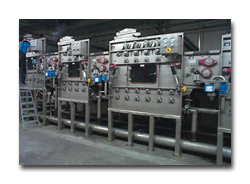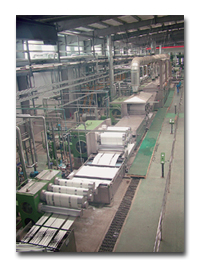The second Forum organized by UCMTF, the French Textile Machinery Manufacturers’ Association, was
an opportunity to further enhance relations with the students of the four colleges which train
engineers for the textile-related industries, to address their concerns about the geographical
changes in this sector, and to review the careers offered by the textile machinery industry.
More than 250 manufacturers, teachers and students were gathered at UCMTF’s invitation in the
new facilities of ITECH (Lyon Textile and Chemical Institute) on the Lyon university campus.
ITECH’s students had been joined by those from ENSAIT in Roubaix, ENSITM in Mulhouse and ESTIT in
Lille. The great number of questions that were asked showed that this year’s theme, “French
Manufacturers and Globalization”, was a crucial issue.
The French manufacturers’ dynamism is obvious. The forty or so companies in membership of
UCMTF achieve a turnover of nearly 1 billion, ranking fifth in the world. They employ more than
4,000 people and over 90 percent of their sales are exported to more than a hundred countries all
over the world. When giving these figures, Bruno Ameline, President of UCMTF, stressed that the
textile machinery market was dominated by the European manufacturers for historical reasons of
course, and also mainly because of their commitment to those customers who formulate the most
requirements both for the development of new products and in terms of reliability, productivity and
versatility. To meet these requirements and provide services beyond the mere sale of machines is
the best way to cater closely for the market needs and, as a result, to maintain positions of world
leaders.
Gildas Minvielle of IFM (French Fashion Institute) put in perspective textile globalization
and the shift of manufacturing to Asia, and was asked a great number of questions by the students.
They expressed their realism about challenges, and their hopes for new products, in particular
industrial fabrics, for the opening of Asian markets to upmarket products, and for the Paneuromed
area, a credible alternative to faraway production.
Four panel discussions, led by Michel Sotton, the former Director-general of IFTH (French
Textile-Clothing Institute), and including students for the first time to pass questions on, were
then organized on the various textile technologies :
– Combing-Spinning-Yarn processing Companies represented: Laroche (Jean-Christophe Morel),
NSC Fibre to Yarn (Alain Etancelin), ECC Platt (Paul Verbecke), Rieter FYT (Marc Desrayaud,
Jean-Yves Dussaud), Fil control (Jean-Marc Balois).
After presenting their companies, the speakers answered questions and showed how they were
able to achieve global business development by setting up service centres in a first stage, then
commercial companies, before succeeding in producing locally. It was necessary to hire young
graduates at each stage of this process.
– Technical Textiles and Nonwovens Companies represented: NSC Nonwoven (Benoit Gallais),
Laroche (Jean-Christophe Morel, Benoit Rombaut), ECC Platt (Paul Verbecke), Rieter Perfojet (Cic
Laurent).
For nonwovens, the speakers highlighted the high commitment to producers of finished products
and the need to offer “turnkey” solutions, and therefore the need to develop close partnerships
with manufacturers of complementary machines to propose complete lines.
– Weaving-Printing-Cutting Companies represented: Stli (Max Michel and JoJu), Ateliers de
Belmont (Gregory Calandry), Lectra ( M. Costa).
Beyond technological questions, the major challenge is to help customers resolve their own
challenges, and in this respect consultancy and training are now essential services. They offer
real opportunities for students and the possibility of making a career via different jobs within
the same company.
– Finishing and nanotechnologies Companies represented: Alliance (Jean-Paul Bkian), Superba
(Jean-Pierre Ummenhover), Rousselet (Luc Buisson), ITECH ( Fabien Roland).
In this sector, commitment to customers is all the more necessary because, besides the
development of specific machinery and processes whereby the machine becomes a key factor of product
innovation, the buying decision is now taken on the basis of an economic analysis, hence long and
extensive studies requiring total mutual trust.
Bruno Ameline concluded the event by thanking Jean-Pierre Gallet, Director-general of ITECH,
for hosting the Forum; he announced another edition, and pointed out four major qualities to make a
successful career in the textile machinery industry, i.e. to have a taste for industry (factories,
men), for international business (languages and travels), for (long-lasting) service, and for
continuous creativity.
Press release courtesy of UCMTF
July 2005








